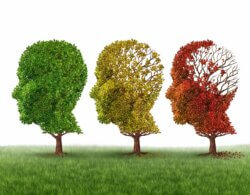June 22, 2021

Alzheimer’s Disease: My Personal Journey and Search for a Cure
My personal journey with Alzheimer’s began in 2005 when my wife, Valerie, received her diagnosis with this terrible disease, one that robs the afflicted of their minds and forces family and friends to watch with dread as their loved one slowly disappears.
Stunned by the news, I was overwhelmed with grief for my life partner and the loss of our future together. Valerie was a vivacious, energetic person with a passion for education, which we shared. After her diagnosis, I began a quest to better understand the cause of the disease and to find new approaches and therapies that might prevent, delay or reverse its spread in others.
There is so much we don’t yet understand about Alzheimer’s disease, but its devastating impact is growing. In the U.S., there are 6.2 million patients, a number expected to more than double by 2050. [1] In 2018, more than 120,000 Americans died from the disease, making it the nation’s sixth leading cause of death. [2] Almost two-thirds of patients are women, but there is no explanation for this gender discrepancy. [3] In the U.S., the cost of treatment and care for these patients for 2020 is estimated at more than $300 billion. The total cost, factoring losses in income, life savings and productivity, is many times higher.[4]
Scientists have conducted more than 400 clinical drug trials over the last 14 years searching for a pharmaceutical cure. [5] All have failed. This month, the Food and Drug Administration approved a Biogen drug, aducanumab, as a treatment to slow cognitive decline in Alzheimer’s patients. The FDA’s advisory committee, however, overwhelmingly recommended against approval because there is so little evidence in clinical trials that the drug works. Three members of the committee have resigned from the committee in protest of the agency’s decision.
The lack of progress in developing an effective drug, or a combination of drugs, that will treat the disease once it arises suggests that we’ve been looking at this problem in the wrong way. Instead, effective therapies may require systemic approaches based on the principles of science-driven wellness. In my own search for answers, I learned that some important discoveries are being made.
For instance, Michael Phelps, a UCLA biophysicist and the inventor of the PET scan (the technology that produces images of disease changes in the body), has found that some of the chemical changes in the brain as a person moves from wellness to Alzheimer’s disease occur from four to 10 years before any clinical diagnosis could be made. It should be possible to develop a blood test through clinical trials that can detect blood biomarkers reflecting those brain changes at a very early stage in the transition to illness. With such information, patients could begin treatment long before the disease has reached its traditional diagnosable stage.
But what kind of treatment would this be?
Just as we’ve long known that exercise, healthy diets and the avoidance of harmful habits such as smoking can stave off heart disease, studies have shown that a person’s lifestyle can play a big role on whether and how fast the disease progresses.
One researcher, Dale Bredesen, for example, has focused on a systems approach to stabilizing the synaptic connections between nerve cells that are lost in this disease. He has begun studies to validate the idea that treatment should be “multimodal” — and based on correcting a patient’s unique deficiencies, assessed by analyzing their blood and other factors such as environmental toxins, diet, exercise and sleep.

In a groundbreaking study, a team of Finnish and Swedish researchers found that non-drug-based approaches can work as interventions for older adults with elevated risk for dementia.
The Finnish Geriatric Intervention Study to Prevent Cognitive Impairment and Disability, also known as FINGER, was a two-year, double-blind, randomized controlled trial that included 1,260 people. The participants were placed into a program that included dietary guidance, exercise, cognitive training and social activities, along with intensive monitoring and management of metabolic and vascular health.
In essence, the participants who were selected to receive the interventions underwent something akin to a science-based wellness approach. There was some skepticism when the FINGER study was announced. Many of the interventions had been tried before on dementia patients, often with disappointing results. But the researchers weren’t convinced that these approaches were all dead ends. Exercise alone might not move the needle much. Cognitive training by itself might be relatively fruitless. Socialization, in and of itself, might not do much. But the whole might be greater than the sum of its parts — and indeed it was.
By the end of the trial, the patients who had received the multiple interventions were far more likely than the control group to have maintained — and even improved — their cognitive functioning. Their memories were stronger. Their ability to pay attention and maintain that attention was better. The relationship between their thoughts and physical movements was sharper.
To maintain brain health, we need to intervene with multimodal therapies as early as possible. The key will be determining the particular susceptibilities of each individual and designing a combination of interventions specific to that person.
The Institute for Systems Biology has set up several clinical trials on multimodal therapies and is now setting up a clinical trial with 1,000 individuals at high risk for Alzheimer’s. The study will conduct genomic and other tests (including quantification of 1,000 blood analytes and gut microbiomes) twice a year on each participant, while tracking their digital health measurements with wearable technology like Fitbits.
With these data, we should be able to detect transitions from wellness to Alzheimer’s at their earliest stages. In similar studies of healthy adults, we have been able to identify outlier blood analytes that are biomarkers for early detection for several types of cancer, years in advance of clinical diagnosis.
With the growing evidence of the effectiveness of multimodal therapies, families with a history of Alzheimer’s will have good reason to undergo genetic testing to assess their risk. Everyone has two copies of the APOE gene. One defective form of this gene, APOE4, is associated with Alzheimer’s. With one copy of APOE4, an individual has a 12% greater chance of developing the disease by 65 years of age. With two copies, that rises to 65%.
Given Valerie’s diagnosis, my children and I decided to get tested. It turned out that Valerie and I each have one copy of the APOE4 gene. My daughter was relieved to learn that both her APOE genes are normal. However, my son has two defective copies of the gene, making him more likely to develop Alzheimer’s later in life. This sobering news has caused him to adopt an individualized multimodal plan with changes to his lifestyle, environment and blood chemistries that could potentially prevent the disease’s onset.
Although much more research is needed, multimodal therapies could become central in the fight against Alzheimer’s. And new blood tests could help those at high risk for Alzheimer’s adopt preventive therapies early. If these advances are successful, we may be able to imagine a world where far fewer families will have to experience the pain of this terrible disease.
This article originally appeared in the LA Times on June 20, 2021.
Bonus Footage
LA Times produced two short interviews related to this article. One introduces you to Leroy Hood so you can hear his personal connection to Alzheimer’s. The other is with Eran Hood, Dr. Hood’s son, who shares his thinking about his genetic predisposition for Alzheimers and what he’s doing to reduce his risk.
Sources
- https://www.alz.org/alzheimers-dementia/facts-figures
- https://alz-journals.onlinelibrary.wiley.com/doi/full/10.1002/alz.12068
- https://www.ncbi.nlm.nih.gov/pmc/articles/PMC6311541/
- https://www.sciencedaily.com/releases/2019/07/190730092616.htm
- https://www.labiotech.eu/in-depth/alzheimers-disease-clinical-trials/
Read More
Find other articles and content from Leroy Hood on 4sighthealth.com.
- The Science of Wellness March 23, 2021
- Long-Haul COVID: Real, Complex and Challenging April 20, 2021
- Scientific Aging: The Genetic Basis for Longer, Healthier Lifespans June 3, 2021





